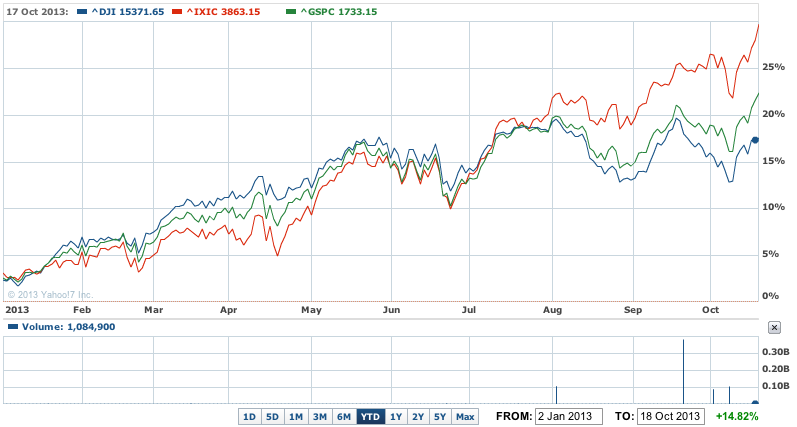We saw records, new multi-year highs and solid gains all round in many equity markets last week as the US debt and budget crisis passed. China produced solid third quarter growth data and the chances of the US Federal Reserve starting to cut its huge spending program receded a bit further into 2014.
Oil and gold were mixed to weaker on Friday, the US dollar weakened, Australian shares hit a five year high and the Aussie dollar ended the week with a 2 US cent gain.
At one stage on Saturday morning it touched 97 US cents.
MSCI’s index that tracks the equity performance of 45 countries rose 0.7% on Friday to highs last seen in January 2008, while the Stoxx Europe 600 rose for a seventh successive day, its longest winning streak so far this year.
In the US, the Standard & Poor’s 500 closed at a record high for the second consecutive day on Friday.
The Dow was up 24.98 points at 15,399.65. The S&P 500 Index rose 11.35 points, to 1,744.50 and the Nasdaq composite added 51.13 points, or 1.32%, to 3,914.28.
For the week, the Dow rose 1.1%, the S&P was up 2.4% and the Nasdaq advanced 3.2%, thanks to record results from Google for the third quarter.
The Nasdaq composite is trading at levels last touched in September 2000 but is still 24% from its peak before the tech bubble burst earlier that year.
US Markets YTD – Dow, Nasdaq, S&P continue winning streak

The US dollar fell to eight-and-a-half-month lows against the euro and a basket of six major currencies on Friday on expectations the Federal Reserve will delay reducing its $US85 billion monetary stimulus.
The Australian dollar rose to a four-month high, helped by data showing China’s annual economic growth quickened to 7.8% percent in the third quarter. It last traded at 96.77, up 2.12 cents on the close a week ago.
European shares had a seventh winning day on Friday with the Stoxx 600 index up 0.8% on the day and a very solid 2.2% for the week.
German shares hit an all time highs late in the week, ending on a new record on Friday for a gain of 1.6% for the week. France’s CAC Index was up 2.1%. In London, the FTSE 100 was up 2.1% for the week after seven up days in a row.
New York Comex gold for December delivery fell $US8.40, or 0.6%, to settle at $US1,314.60 an ounce, early Saturday, our time. Following a 3.2% surge in prices Thursday, prices ended the week up 3.7%. Gold had fallen 3.2% the week before.
Comex December silver shed 3 cents, or 0.2%, to end at $US21.91 an ounce, but after jumping 2.7% on Thursday, it finished with a weekly gain of 3.1%.
Comex copper for December delivery was little changed at $US3.30 a pound on Friday for a 0.9% gain over the week.
Oil went a different route: New York WTI crude futures rose 14c on friday to $US100.81 a barrel, but lost 1.2% over the week. Brent crude in London rose 83 cents to $US10.9.94 a barrel, down 0.5% for the week.
In Australia, the market had a good week and is poised to continue that advance today with share price futures showing a 22 point gain.
The ASX200 jumped 38.4 points, or 0.7%, to 5321.5, while the All Ords rose 39.1 points, or 0.7%, to 5321.0.
All sectors ended higher, with the gold sub-index jumping 5 %, financials added 0.8% and materials rose 0.3% on Friday.
For the week the ASX 200 was up 1.7%.
Westpac rose 3%, the CBA was up 2.6%, the Nab ended 3.2% higher and the ANZ added almost 2%. Telstra rose 1.2%.
BHP Billiton added 1.8% (it releases its September quarter production report tomorrow), Rio Tinto rose 3% after its solid production report and Fortescue was up 6%.
Dog of the week was poor Oz Minerals, down 32% after its 2013 downgrade in its September quarter production report.













